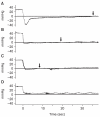Effect of airway pressure on lumbar epidural pressure during positive pressure ventilation
- PMID: 21927684
- PMCID: PMC3167133
- DOI: 10.4097/kjae.2011.61.2.138
Effect of airway pressure on lumbar epidural pressure during positive pressure ventilation
Abstract
Background: The purpose of this study was to measure lumbar epidural pressure (EP) during the insertion of a Tuohy needle under general anesthesia and to evaluate the influence of airway pressure on EP.
Methods: Lumbar EP was measured directly through a Tuohy needle during intermittent positive pressure ventilation in fifteen patients. Mean and peak EP were recorded after peak inspiratory pressures (PIP) of 0, 15, and 25 cmH(2)O.
Results: All measured lumbar EPs were positive, with the pressure increasing during inspiration and decreasing during expiration. Median EP was 6.0 mmHg (interquartile range, 4.0-8.0) at 0 cmH(2)O of PIP, 6.5 mmHg (4.5-8.5) at 15 cmH(2)O, and 8.5 mmHg (6.0-10.5) at 25 cmH(2)O, increasing significantly at 15 cm H(2)O PIP, and further increasing at 25 cmH(2)O (P < 0.001).
Conclusions: We demonstrate the influence of increased airway pressure on lumbar EP measured directly through a Tuohy needle. Lumbar EPs were positive, and increasing PIP levels significantly increased lumbar EP.
Keywords: Epidural pressure; General anesthesia; Lumbar.
Figures



References
-
- Usubiaga JE, Moya F, Usubiaga LE. A note on the recording of epidural negative pressure. Can Anaesth Soc J. 1967;14:119–122. - PubMed
-
- Igarashi T, Hirabayashi Y, Shimizu R, Saitoh K, Fukuda H. The epidural structure changes during deep breathing. Can J Anaesth. 1999;46:850–855. - PubMed
-
- Iwama H, Ohmori S. Continuous monitoring of lower thoracic epidural pressure. J Crit Care. 2000;15:60–63. - PubMed
-
- Shah JL. Positive lumbar extradural space pressure. Br J Anaesth. 1994;73:309–314. - PubMed
-
- Visser WA, Gielen MJ, Giele JL. Continuous positive airway pressure breathing increases the spread of sensory blockade after low-thoracic epidural injection of lidocaine. Anesth Analg. 2006;102:268–271. - PubMed
LinkOut - more resources
Full Text Sources

